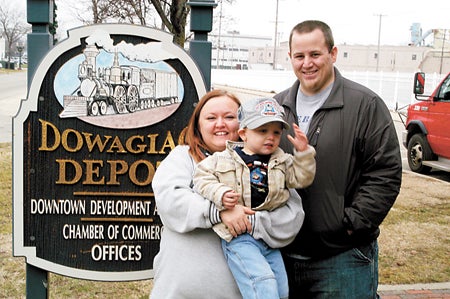Depot geocache hides in plain sight
Published 10:22 am Monday, December 24, 2012

Austin and Katrina Race with their train-loving son Corbin, 2 1/2, at the Dowagiac depot Tuesday. Corbin inspired “Little Geo-(Race)rs Whoo Whoo Cache 3” concealed there.
The prize is not exactly a pot at the end of a rainbow, but Dowagiac is thick with geocaching, an outdoor treasure-hunting game.
“We originally started with letterboxing, which is similar, except you follow clues instead of (smartphone) apps,” said Katrina Race.
“One reason we got into this was we found there are over 120 within a five-mile radius of Dowagiac. With letterboxing, there were maybe 10,” said her husband, Austin, who works at Four Winds Hartford. “A lot of people put them out. They even have events. There was one at Russ Forest in September and at Fernwood in October. There are probably 50 just in Russ Forest. The Van Buren Trail from Hartford to South Haven has 120.” Old metal ammo boxes made popular caches (pronounced “cashing,” like a check.
Letterboxing combines elements of orienteering, art and puzzle solving.
Letterboxers hide small, weatherproofed boxes in publicly accessible places, such as parks, and distribute clues to finding the box in printed catalogs, on one of several web sites or by word of mouth.
Individual letterboxes usually contain a notebook and a rubber stamp. Finders imprint the letterbox’s stamp, either on a personal notebook or on a postcard, and leave an impression of their personal stamp on the letterbox’s visitor logbook as proof of having found the box and letting other letterboxers know who visited.
“With (geocaching), you follow GPS (global positioning system, a satellite-based navigation system consisting of a network of 24 orbiting satellites) and there’s a lot more,” said Katrina, who is a photographer and stay-at-home mom to Corbin, 2 1/2, who’s been wild about “whoo whoos” since visiting the Elkhart train museum.
Geocaching combines technology with adventure while exploring locations.
It goes well with hiking, camping, biking or boating.
“You find places you didn’t know exist and enjoy a family day,” she said.
The Races have pursued their hobby in Chicago and as far away as Ohio.
As for the “treasure,” a geocache contains a log to sign and maybe items to trade, but the journey to its location is often the allure.
There are geocaches on every continent, from Antarctica to North America.
They may be in a nearby park, at the end of a long hike, underwater, up a tree or alongside a city street.
Race’s page’s “attributes” detail for the depot — available in winter, recommended at night, available 24/7, stealth required, wheelchair accessible, parking available, takes less than an hour, kid friendly, “park and grab.”
Since their cache — a Kraft mayonnaise jar painted the color of combat fatigues — was placed Dec. 11, at least four groups have found it.
Most common trackables are Travel Bugs and Geocoins. The former is a tag that attaches to an item geocachers move from cache to cache. Each tag is etched with a unique code, which the finder can use to log travels on the website. Geocoins are trackable coins created by geocachers to commemorate special events or as a signature item to leave in geocaches. They function like Travel Bugs and should be moved from cache to cache unless otherwise specified by owners.
There’s a bit about the depot, built in 1903 by Michigan Central Railroad in Gothic architecture and restored in 1995. The cache was placed with permission from Greater Dowagiac Chamber of Commerce and the City of Dowagiac.
Family-friendly geocaches are hidden in plain sight and never buried, but often cleverly camouflaged. It can take longer to find depending on environmental obstacles. If you take “swag” from the cache, leave something of equal or greater value. Katrina collects path tags.
“The largest one we’ve found is someone built a fake outhouse,” Austin said.
Author John Grisham promoted “Racketeer” with Geocoins.
Write about your find in the log, and log your experience and share your stories and photos online at www.geocaching.com; 4,247,814 new logs have been submitted in the last 30 days,” scrolling by from Germany and Portugal.






